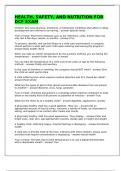HEALTH, SAFETY, AND NUTRITION FOR
DCF EXAM
Children who have physical, emotional, or behavioral conditions that affect or delay
development are referred to as having: - answer-Special needs
True or False: Short term illnesses such as ear infections, colds, broken legs may
only last a few days, weeks, or months - answer-True
To prevent, identify, and control illness in a child care environment, a caregiver
should perform a what with each child upon entering and leaving the program? -
answer-Daily health check
When you take an infants temperature by the auxiliary method, you are taking the
temperature: - answer-Under the arm or armpit
You can take the temperature of a child over three years of age by the following
method: - answer-Orally and auxiliary
In the case of diarrhea or vomiting, the caregiver should NOT what? - answer-Give
the child an adult sports drink
A child suffering from what requires medical attention and 911 should be called? -
answer-Heat stroke
What are the types of germs that spread communicable diseases from one person
to another? - answer-Bacteria, virus, fungi, parasites
True or False: Universal precautions is a strategy which requires caregivers to treat
blood or any bodily fluid of all persons as potential of infection - answer-True
What are the three As of a healthy child? - answer-Appetite, appearance, activity
A physically healthy child has a good appetite. They can: - answer-Eat an
appropriate amount of food at times, consume a vareity of foods, be interested in
eating, and appear to be content after meals and snacks
A physically healthy child has good appearance. They display: - answer-Clear and
bright eyes, clear skin, age-appropriate muscles, steady gain in height and weight
A healthy child, reflecting happy, cheerful feelings is displaying: - answer-Emotional
health
A child who is friendly most of the time, interacts with other children, enjoys quiet
activities that require concentration is displaying: - answer-Social health
True or False: The best way to take temperature is to use a digital thermometer
with a disposable sheath - answer-True
, True or False: For mild diarrhea, give the child milk to drink - answer-False
True or False: For both diarrhea and vomiting, stop the child's normal diet and give
electrolytes - answer-True
Hib is an infection that can lead to other conditions which can cause secondary
infections in many area of the body including: - answer-Meningitis, pneumonia,
epiglottis infection
True or False: Hepatitis B and C are diseases of the liver - answer-True
Conjunctivitis is: - answer-Pink eye
Proper defrosting of food items is displayed by: - answer-A slowly thawing of frozen
food products under refrigeration, thawing food completely submerged under water,
food product must be completely cooked within four hours, thawing in a microwave
oven
Cross-contamination occurs through: - answer-Dirty hands, food contact surfaces,
knives and utensils, storing raw products above cooked food in the refrigerator, etc.
True or False: Antibiotics have no effect on a virus - answer-True
True or False: Common examples of parasites are pin worms, roundworms, and
head lice - answer-True
True or False: The eggs of head lice are called nits - answer-True
Methods through which diseases are transmitted are: - answer-Respiratory,
fecal/oral, direct contact, blood borne
A child should be isolated if you see: - answer-Severe coughing, diarrhea, pink eye,
exposed or open skin lesions
True or False: Each child must have a current record of immunization history and
health record on file at the child care program - answer-True
For proper food handling in preventing illness, good sanitation requires: - answer-
Clean utensils and equipment, wholesome food, correct storage and cooking
temperatures, safe food handling practices
Caregivers needs to pay attention to the following while administering medication: -
answer-Name of recipient on medicine bottle, dosage, the time and date of last
dosage, permission slip from the parent
The following steps are for the proper method of changing latex gloves in correct
order: - answer-Grasp palm, pull glove toward fingers turning it inside out, throw the
glove in a plastic bag that can be sealed, run your ungloved finger under the
remaining glove, pull glove off turning it inside out, put soiled glove in a plastic bag




